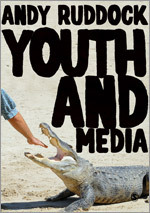
|
Youth Media, Andy Ruddock, Sage, 2013, 215 pages, $34.00, 978-1-848600928 Review by Michele Sleighel Examining youth and media should include a constant consideration of the ways that researchers and academics have treated youth behavior, media influence and media literacy. According to author Andy Ruddock, understanding that each of those factors must be considered in a greater social context, which is explained through case studies presented in each of this book’s chapters, is vital to understanding media effects. Ruddock currently teaches at the University of Monash and has authored other books about media, including Investigating Audiences and Understanding Audiences.
In order to make sense of the vast information and often ambiguous assumptions surrounding youth and media, Ruddock lays out three comprehensive questions, beginning with, “Why do media matter?” (p. 1). He also asks why youth are so often tied to media studies and how researchers have explained media influence on young people. He answers all three questions fully by examining a large scope of interesting information that allows the reader to conceptualize youth media and its importance.Ruddock’s explanation of his overarching way of looking at youth media provides an in depth context that reels in members of academia, critics of media and communication students as potential readers of this book. To answer the question of how researchers have understood youth media before, Ruddock places an analysis of media studies in the context of debasing old assumptions about effects research and its supposed attempt to explain how youth are affected by media. He instead invokes an argument for “a broader understanding of media influence” (p. 2) through political, historical and ordinary frames. This broader view is understood though examinations of case studies that answer the author’s first two questions about why youth and media matter. Ruddock explains their importance by providing ample evidence that the two are politically influential and serve as accurate reflections of society’s state and the ordinary person’s thoughts about themselves and society. The cases are comprised of youth and media situations all over the world, including United States American soldiers in Afghanistan, young girls in Palestine, instant messaging and girls’ identities, activist leaders in the Arab world, reality television stars and media in China, violence in media and music, students and alcohol, Barack Obama’s use of social media in political messaging, and U.S. American celebrity. Different case studies invoke different theories and research. Presenting an array of stories from different countries contributes to the author’s comprehensive approach to explaining media. In fact, his explanation of an ethnographic look into cell phone use by Palestinian girls brings into question interesting ideas about subcultures, social influences on identity and media’s role in users’ lives. Researchers pointed out how young girl’s media consumption is often insightful into the societies in which they live. The study revealed that teenage girls were using secret cell phones, usually received from boyfriends without parental permission, to create mediated spaces for exploring gendered and sexualized identities in a world where their lives are mostly constrained by men. In other words, cell phones, according to Ruddock, are important social, political and ordinary tools in developing and understanding what it means to be a young Palestinian woman. Feminist theory is used to discuss how those young women use media. In this section, he argues heavily for the importance of feminist media studies but this theme does not appear in other chapters, provoking possible reluctance to buy the author’s dedication to this argument. What he emphasizes in argument is not reflected in the number of times it is mentioned in the book. A deep look into youth’s cell phone usage is just one case presented in the book. While each story is unique, each has a common theme of media consumption and a contextual backdrop is necessary to understand that usage. In order to thoroughly apply relevance to the studies, each chapter is prefaced with a flow chart that includes six categories: the research question, an underlying question about media influence, social and critical histories, the presentation of the case study, outcomes, and lessons for understanding media influence. Despite the newness and vastness of youth media studies, Ruddock’s analysis through this organized thought process proves comprehensive and interesting. By combining a critical view of media studies with qualitative analysis and thorough contextual consideration, Ruddock’s collection of interesting case studies reveals that media and youth have reciprocal influences that affect society, politics and eventually history. To learn more about author Andy Ruddock visit http://profiles.arts.monash.edu.au/andy-ruddock/. Michele Sleighel is in the master of arts program at the University of Texas at San Antonio, where she studies intercultural and organizational communication. Her research focuses on oppression, marginalization, social intervention, work-life balances, and new media. She received a B.S. in public relations from the University of Texas at Austin. michelesleighel@gmail.com |
||
 He is best known for his combination of qualitative and quantitative research, which can be seen in Youth and Media, as he outlines his argument for the importance of media studies. Ruddock’s overarching argument is that while data collection of what media does is important, it cannot be analyzed without considering social and technological history. In fact, an isolated analysis of media effects has long created political contention, a point that is woven throughout each of the case studies.
He is best known for his combination of qualitative and quantitative research, which can be seen in Youth and Media, as he outlines his argument for the importance of media studies. Ruddock’s overarching argument is that while data collection of what media does is important, it cannot be analyzed without considering social and technological history. In fact, an isolated analysis of media effects has long created political contention, a point that is woven throughout each of the case studies.